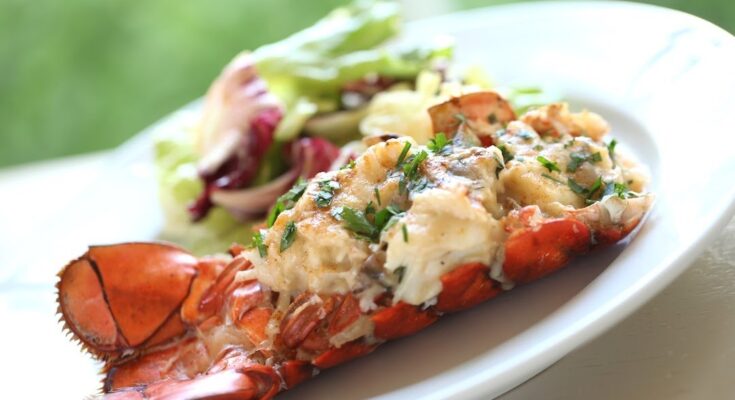Lobster Thermidor Recipe: Lobster Thermidor is one of those dishes that immediately makes you think of luxury dining and fine French cuisine. Originating in Paris during the late 19th century, this dish is known for its rich, creamy, and indulgent flavors that bring out the best in lobster. Unlike simple boiled or grilled lobster, Thermidor is all about elegance—it combines tender lobster meat with a velvety sauce made of egg yolks, cream, mustard, and cheese, then stuffed back into the lobster shell and baked to perfection.
But why has this dish stood the test of time? Simply put, Lobster Thermidor is a beautiful balance of flavors. The lobster meat remains the star, but the sauce enhances it with layers of richness and a slightly tangy kick. This combination is so beloved that it has become a staple in French fine dining and has spread worldwide as a symbol of indulgence.
If you’ve ever wanted to recreate restaurant-style Lobster Thermidor at home, don’t worry—it’s easier than you think. With the right ingredients and a bit of patience, you can enjoy this classic French masterpiece in your own kitchen.
What is Lobster Thermidor?
Lobster Thermidor is essentially a stuffed and baked lobster dish. The lobster meat is first cooked, then removed from the shell. It’s chopped into bite-sized pieces and mixed with a creamy, cheesy sauce made with egg yolks, cream, white wine, mustard, and Gruyère or Parmesan cheese. After that, the mixture is spooned back into the lobster shells, sprinkled with more cheese, and baked until golden brown and bubbling.
The name “Thermidor” itself comes from the French Revolutionary calendar—it was created in 1894 at a Paris restaurant and named after the play Thermidor that was popular at the time. Since then, it has remained one of the most luxurious lobster dishes in culinary history.
What makes it unique compared to other lobster recipes is that it doesn’t just rely on butter or garlic. Instead, it’s a full-bodied meal with layers of creaminess, sharpness from mustard, and depth from the wine and cheese. It’s indulgence at its finest.
Why This Classic French Dish is So Special
There are plenty of lobster recipes out there—grilled, steamed, broiled with butter—but Lobster Thermidor stands apart because of its sophistication. It’s not just a dish; it’s an experience. Here’s why it’s so special:
- Perfect Balance of Flavors – The richness of cream and cheese balances perfectly with the light sweetness of lobster.
- Restaurant-Quality at Home – While it looks fancy, it’s surprisingly achievable at home with the right steps.
- A Dish for Special Occasions – Lobster Thermidor is often served on holidays, anniversaries, or fine dining occasions, making it a celebration-worthy recipe.
- Visually Stunning – The presentation—lobster shells stuffed with a golden, bubbling filling—makes it a true showstopper at the dinner table.
Cooking Lobster Thermidor is like painting with flavors. Each ingredient adds a brushstroke that transforms simple lobster meat into a masterpiece. It’s indulgent, yes, but sometimes life calls for a little indulgence, don’t you think?
Ingredients You’ll Need
The magic of Lobster Thermidor lies in the ingredients. While it may sound complicated, most of the items are easy to find. The key is using fresh, high-quality lobster and balancing the richness of the sauce with sharp, flavorful cheese and seasonings. Let’s break it down:
Fresh Lobster
The star of the dish, obviously. You’ll need about 2 whole lobsters (around 1 ½ pounds each) to serve 2–3 people. If live lobsters aren’t available, you can use pre-cooked lobster tails, but fresh lobster will give the best texture and flavor.
Dairy & Cheese Essentials
- Heavy Cream – For that luscious, silky sauce.
- Egg Yolks – Helps thicken and enrich the mixture.
- Butter – Adds depth and richness.
- Cheese – Gruyère is the traditional choice, but Parmesan or Cheddar can work too.
Vegetables & Herbs
- Shallots or Onions – For a mild, sweet base flavor.
- Garlic – Optional, but adds aroma.
- Fresh Parsley or Tarragon – For a pop of freshness.
Wine, Spices & Seasonings
- Dry White Wine (like Sauvignon Blanc or Chardonnay) – Adds acidity and depth.
- Dijon Mustard – Brings a tangy kick to balance the richness.
- Nutmeg – A pinch adds warmth.
- Salt & Pepper – To taste.
Optional Ingredients for Extra Flavor
- Mushrooms – Often included in variations of Thermidor.
- Paprika or Cayenne – For a slight spicy note.
- Lemon Juice – To brighten up the sauce.
By now, you can already imagine the flavors—creamy, cheesy, savory, with just enough tang to cut through the richness. The ingredients may seem indulgent, but that’s exactly what makes Lobster Thermidor a luxury worth experiencing.
Kitchen Tools & Equipment
Before diving into the recipe, let’s make sure you have the right tools. Lobster Thermidor isn’t complicated, but having the right equipment makes the process smoother.
Must-Have Utensils
- Large pot (for boiling lobsters)
- Sharp kitchen shears (to cut shells)
- Heavy-bottomed saucepan (for the sauce)
- Baking sheet or oven-safe dish
- Tongs or seafood crackers (to handle lobster shells)
- Whisk (for blending the sauce)
- Oven or broiler (for baking to golden perfection)
Pro Tips for Preparation
- Prepare all your ingredients beforehand—this is a classic French dish, and timing matters.
- If handling live lobster feels intimidating, many fishmongers will steam them for you.
- Always taste your sauce before stuffing—balance is key!
Having these essentials at hand ensures your Lobster Thermidor experience is stress-free and enjoyable.
Step-by-Step Guide to Making Lobster Thermidor
Now that you’ve got your ingredients and tools ready, let’s dive into the actual cooking process. Don’t worry—it’s much easier than it looks. Just follow these steps carefully, and you’ll have a restaurant-quality Lobster Thermidor on your dining table.
Step 1 – Preparing the Lobster
Begin by boiling or steaming whole lobsters until just cooked through (about 8–10 minutes depending on size). Remove them from the heat and let cool slightly. Carefully split the lobsters in half lengthwise, then scoop out the meat from the claws and tails. Chop the lobster meat into bite-sized pieces and set aside. Save the empty shells, as they will be used for stuffing later.
Step 2 – Making the Creamy Sauce
In a pan, melt some butter and sauté finely chopped shallots or onions until soft. Add a splash of brandy or white wine and let it simmer to reduce slightly. Stir in heavy cream, Dijon mustard, and a little grated Parmesan or Gruyère cheese. Season with salt, pepper, and a pinch of nutmeg for warmth. The result should be a rich, velvety sauce.
Step 3 – Combining Lobster Meat with Sauce
Add the chopped lobster meat into the creamy sauce and mix gently until the meat is coated and warmed through. Be careful not to overcook at this stage—you want the lobster to remain tender and juicy.
Step 4 – Stuffing and Baking the Lobster Shells
Spoon the lobster-and-sauce mixture back into the reserved lobster shells. Top generously with extra grated cheese and breadcrumbs for a golden crust. Place the stuffed shells on a baking tray and bake in a preheated oven at 400°F (200°C) for about 8–10 minutes, or until the top is bubbly and golden brown.
Step 5 – Final Touch and Serving
Remove from the oven and let cool for a couple of minutes before serving. Garnish with fresh parsley or chives and serve hot with lemon wedges on the side. Lobster Thermidor pairs beautifully with a crisp salad, roasted vegetables, or a glass of chilled white wine.
Expert Tips for the Perfect Lobster Thermidor
Even though Lobster Thermidor is straightforward, small details can make a huge difference. Here are some expert tips:
Choosing the Best Lobster
- Always choose live lobster if possible. The fresher, the better.
- If using frozen lobster tails, thaw them overnight in the fridge for the best texture.
Balancing Flavors in the Sauce
- Don’t overdo the mustard; it should enhance, not overpower.
- Use a dry white wine—avoid sweet wines, as they throw off the balance.
Avoiding Common Mistakes
- Overcooking lobster makes it rubbery—cook just until opaque.
- Too much cheese can overwhelm the lobster flavor. Use it to complement, not dominate.
- Sauce splitting? That happens if egg yolks are added over high heat. Always remove the pan before whisking them in.
Think of it like this: Lobster Thermidor is all about balance. Too much of anything—wine, mustard, cheese—can ruin it. Keep it creamy, rich, but not overpowering, and you’ll have the perfect dish every time.
Variations of Lobster Thermidor
Like many classic dishes, Lobster Thermidor has evolved over time. While the traditional French recipe remains iconic, chefs around the world have experimented with different versions. If you love the idea but want to adjust flavors or make substitutions, here are some delicious variations:
Traditional vs. Modern Versions
- Traditional Thermidor uses Gruyère cheese, white wine, mustard, and egg yolks for the sauce. It’s rich, creamy, and exactly what you’d find in a Parisian restaurant.
- Modern Versions sometimes swap Gruyère for Cheddar or Parmesan, skip the egg yolks for a lighter sauce, or add mushrooms for extra depth. Some chefs even add a breadcrumb topping for a crunchier finish.
Substitutions for Cheese and Wine
- Cheese Alternatives – If Gruyère is too strong or unavailable, Parmesan, aged Cheddar, or even Comté can work beautifully.
- Without Wine – If you prefer a non-alcoholic version, replace wine with a splash of chicken or vegetable stock plus a squeeze of lemon juice for acidity.
Seafood Alternatives
If lobster is hard to find or too expensive, you can still enjoy the essence of Thermidor with other seafood:
- Crab Thermidor – Sweet crab meat works wonderfully in the same creamy sauce.
- Shrimp Thermidor – A more budget-friendly alternative that still delivers a luxurious flavor.
- Scallop Thermidor – Tender scallops add an elegant twist.
These variations prove that Thermidor isn’t limited to lobster alone—it’s all about that indulgent sauce and beautiful presentation.
Serving Suggestions
A dish as rich as Lobster Thermidor deserves sides that complement rather than overpower it. The goal is to balance flavors and textures while keeping the focus on the star of the show.
Side Dishes that Pair Perfectly
- Steamed Asparagus or Green Beans – Their freshness cuts through the creaminess.
- Garlic Mashed Potatoes – Creamy potatoes with a hint of garlic pair beautifully with the lobster sauce.
- Rice Pilaf – A light, fluffy rice side keeps things balanced.
- Crusty French Bread – Perfect for scooping up every last bit of that sauce.
Wine Pairings for Lobster Thermidor
Since the sauce already uses white wine, serving a complementary wine elevates the experience:
- Sauvignon Blanc – Crisp and refreshing, balances richness.
- Chardonnay (unoaked) – Smooth, buttery notes that echo the sauce.
- Champagne – For the ultimate luxurious pairing, sparkling wine works beautifully with lobster.
Imagine this: Lobster Thermidor served with buttery asparagus, a side of creamy mashed potatoes, and a chilled glass of Champagne. That’s a five-star meal without leaving your home.
Nutritional Value of Lobster Thermidor
Lobster Thermidor may be indulgent, but it’s also surprisingly nutritious when eaten in moderation. Lobster itself is lean and high in protein—the richness mostly comes from the sauce.
Calorie Breakdown
- Lobster Meat (per serving, 1 cup): ~140 calories
- Cream and Cheese: ~200–250 calories
- Butter and Egg Yolks: ~150–200 calories
In total, a single stuffed lobster half can range between 500–700 calories, depending on portion size and cheese used.
Protein, Fats, and Carbs
- Protein: Lobster is an excellent source of lean protein. A single serving packs around 25–30g.
- Fats: Most of the fat comes from cream, butter, and cheese. These fats are indulgent but fine in moderation.
- Carbs: Very low, except for small amounts from cream and wine.
Tip: If you want a lighter version, you can reduce cream and cheese or use half-and-half instead of heavy cream.
Storing and Reheating Lobster Thermidor
Since Lobster Thermidor is rich and filling, you might end up with leftovers. The good news? It stores and reheats beautifully if done properly.
Refrigeration Tips
- Store leftovers in an airtight container or cover tightly with foil.
- Keep refrigerated for up to 2 days.
Freezing and Reheating
- You can freeze stuffed lobster shells before baking. Wrap tightly in plastic wrap, then foil, and freeze for up to 1 month.
- To reheat, thaw overnight in the refrigerator, then bake at 350°F (175°C) until warmed through and bubbly.
Avoid microwaving, as it can make the lobster rubbery. Always reheat in the oven for best results.
FAQs about Lobster Thermidor Recipe
1. Can I make Lobster Thermidor without wine?
Yes! Simply replace the wine with chicken or vegetable stock and add a squeeze of lemon juice for acidity.
2. What cheese works best for Lobster Thermidor?
Gruyère is traditional, but Parmesan, aged Cheddar, or Comté are excellent substitutes.
3. Can I use frozen lobster?
Yes, but thaw it properly overnight in the fridge. Fresh lobster will always give the best flavor and texture.
4. How long does Lobster Thermidor last?
It keeps well in the fridge for up to 2 days or can be frozen (before baking) for up to 1 month.
5. What’s the difference between Lobster Thermidor and Lobster Newberg?
Lobster Thermidor is baked with a cheesy mustard-cream sauce, while Lobster Newberg is prepared with a sherry-cream sauce and served over toast or rice.
Conclusion
By following this step-by-step guide, you’ll be able to prepare a dish that not only looks impressive but tastes incredible. Whether you stick to the traditional recipe or try one of the modern variations, Lobster Thermidor will always deliver that “wow” factor at the dinner table.
So, the next time you want to treat yourself—or someone special—remember that this luxurious dish is just a few simple steps away.



